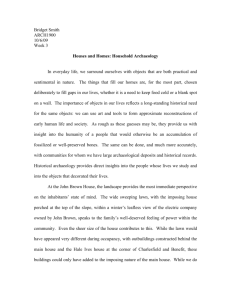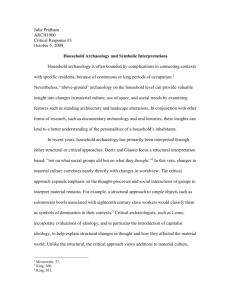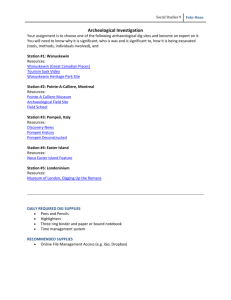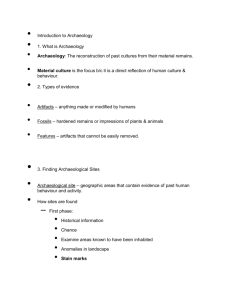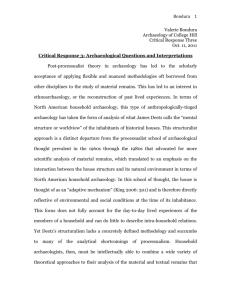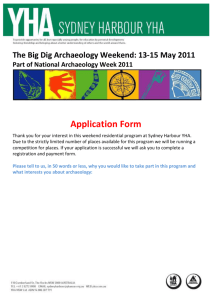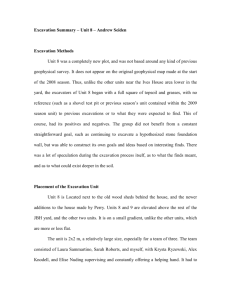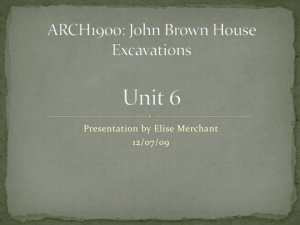Baker3
advertisement
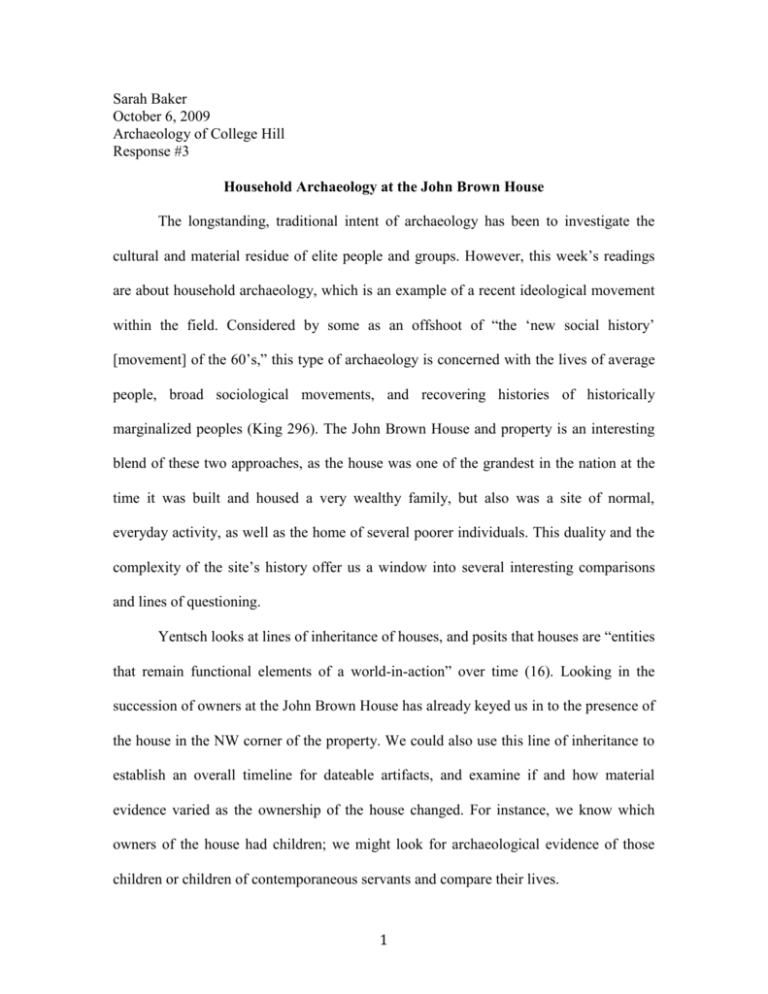
Sarah Baker October 6, 2009 Archaeology of College Hill Response #3 Household Archaeology at the John Brown House The longstanding, traditional intent of archaeology has been to investigate the cultural and material residue of elite people and groups. However, this week’s readings are about household archaeology, which is an example of a recent ideological movement within the field. Considered by some as an offshoot of “the ‘new social history’ [movement] of the 60’s,” this type of archaeology is concerned with the lives of average people, broad sociological movements, and recovering histories of historically marginalized peoples (King 296). The John Brown House and property is an interesting blend of these two approaches, as the house was one of the grandest in the nation at the time it was built and housed a very wealthy family, but also was a site of normal, everyday activity, as well as the home of several poorer individuals. This duality and the complexity of the site’s history offer us a window into several interesting comparisons and lines of questioning. Yentsch looks at lines of inheritance of houses, and posits that houses are “entities that remain functional elements of a world-in-action” over time (16). Looking in the succession of owners at the John Brown House has already keyed us in to the presence of the house in the NW corner of the property. We could also use this line of inheritance to establish an overall timeline for dateable artifacts, and examine if and how material evidence varied as the ownership of the house changed. For instance, we know which owners of the house had children; we might look for archaeological evidence of those children or children of contemporaneous servants and compare their lives. 1 King points out that archaeology has sometimes turned households into “ ‘faceless blobs’, that is, undifferentiated and unproblematised social units” (302). The question of children stated above is just one possible way to complexify the wider John Brown House community. We could also look into the lives and material evidence of women at the house; we might ask whether rich and poor women had similar or different artifacts, or compare the personal artifacts of women and men. Also, we can compare the material residue left by servants as opposed to the owners and their immediate family. King also cites a fascinating study by Mary and Adrain Praetzellis that showed that differences in material evidence across class were actually surprisingly small in their study group of 19th century American households (304-5). It would be interesting to extend that question to the JBH, and compare some of the fragments of evidence we find in the yard to the well-preserved objects in the house itself to investigate if there were clear distinctions of quality (and/or quantity) depending on an individual’s social status. The privy of the Tate family household in Rhode Island, excavated by Mrozowski, revealed several fragments of ceramics whose import to the US was banned during the most likely dates of deposition (53). Looking at issues of illegal objects at the John Brown House would be very interesting. Did the Brown family wealth allow them to have legally or morally questionable objects at their homes? In a less scandalous vein, we might also compare objects found both in the JBH collection and from our unit finds this semester how far away the objects likely came from. We know John Brown was a merchant with connections to China, India and Africa, among other places; might any of the artifacts found in the yard connect to this fact? 2 Mrozowski also discusses the presence of animals at several Rhode Island Households. As far as I know, we’ve yet to find any direct evidence of animals in the yard, but it seems likely that some animals might have been kept there. Depending on if we find such evidence, we should examine whether animals were present at certain times or at certain locations in the life of the JBH. We might be able to determine whether the household slaughtered its own meat or collected its own eggs, and how the presence of animals might have affected the inhabitants of the house and yard. In a similar vein, what kind of gardening went on at the JBH? Who might have worked in these gardens or in indoor food production? These are all questions of household archaeology that we might pursue during the semester. The artifacts which are already well-preserved within the JBH might tie into Leone’s thesis that artifacts reveal developing social values within a society. Watches, telescopes, scientific objects and well-manicured gardens symbolized a cultural value of the power of the intellect over natural; also, sets of dishes, cutlery and personal chamber pots conveyed a social message of cleanliness and etiquette (Leone 240). By fitting the John Brown family’s artifacts into this thesis, we could investigate whether members of the Brown family were trendsetters or rigid observers of social traditions. We also know that a later owner was very interested in bathing and personal hygiene, and we may uncover further evidence of that norm later in the semester. The tour of the JBH interior revealed a grand and carefully planned space, but also a household that was fully lived in. It didn’t, however, reveal much about the servants and upkeep of the household. The formal and informal parlors were heavily decorated and manicured spaces, with servant spaces hidden at the back of the house. The 3 curation of the JBH speaks to a continuing and diehard fascination with the fancy and well-documented lives of the elite. However, our work in the yard and outbuildings shows the beginning of a new ideology, in which a place is investigated from multiple points of view over time and social class. Our work this semester is continuing to uncover evidence of ‘other lives’ at the JBH; hopefully in this sense, we will contribute to a wider understanding of the JBH as not just a house, but also a household. 4 Works Cited King, Julia A. 2006 Household archaeology, identities, and biographies. In D. Hicks and M. Beaudry, eds., The Cambridge Companion to Historical Archaeoloy. Cambridge: CUP, pgs. 293-313. Leone, Mark P. 1988 The Georgian Order as the Order of Merchant Capitalism in Annapolis, Maryland. M. Leone and P. Potter, Jr., eds, The Recovery of Meaning: Historical Archaeology in the Eastern United States. Smithsonian: Washington, 235-262. Mrozowski, Stephen A. 2006 Shifting the Focus: Archaeology of the Urban Household, The Archaeology of Class in Urban America. Cambridge: CUP, pgs. 36-62. Yentsch, Anne. 1988 Legends, houses, families, and myths: relationships between material culture and American ideology. M. Beaudry, ed. Documentary archaeology in the New World, CUP: Cambridge, 5-19. 5
